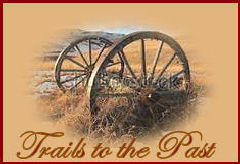|
DESERTED EARLY
SETTLEMENTS
History of
Nevada
Thompson & West -
1881
Ragtown was at one time one of the
most noted localities in the Churchill County
region, being a landmark of the past. In the
earliest times it was a station on the overland
road, when the emigrants moved across the
Forty-mile Desert from Humboldt, and pushed on to
the gold fields of California. When the Simpson
route was discovered and adopted in 1860, and
emigrants came by way of Schell Creek, Egan Canon,
and Jacobsville, on Reese River. Ragtown still
remained an overland station. Asa L. Kenyon
settled at Ragtown in 1854, and has been the only
permanent settler there since, stock-raising being
his avocation. On his arrival there he found 200
people, but they all left in the fall. Two reasons
are assigned for the origin of the novel name of
the town. One is that it was originally composed
of cloth houses built by traders from California,
who, leavinii in the fall, left their ragged
shelters to flutter in the wind. According to
another authority the emigrants, on reaching it,
hastened to divest themselves of their ragged
garments, and plunge into the cooling waters of
the Carson. Long, scattered piles of rags daily
adorned the banks of that stream. There was
once an emigrant burying-ground at Ragtown
containing 200 graves, results of cholera, fever
and exhaustion in early years, which were
variously marked with log-chains, wagon-tires,
etc.
During the flood of 1861-62 it was
completely cov-ered over and obliterated, and a
public road now passes over the
spot.
Shortly after reaching Ragtown,
Kenyon located fifteen miles distant, on the
Forty-mile Desert, where he sunk a well and did a
very good business in the sale of water to
emigrants, his charge for watering stock was
twelve and a half cents per head. He also
bought a store of his cousin, and in connection
with his water enterprise, retailed merchandise
until 1860. At a time when the road was not kept
open regularly, in the winter, a large party of
Indians visited him and desired to purchase gun
caps, upon which Mr. Kenyon raised the price to
$300 per box. They expressed surprise at such an
enormous price, and asked the reason of it. The cap man
is dead, replied Mr. Kenyon. For powder they were
asked $300 per pound. " Is the powder man dead,
too ? " they asked. " No," replied Mr. Kenyon,
"but he is very sick." In 1867 an emigrant named
Fleming perished from thirst on the desert between
the Humboldt and Ragtown. He was out three
days.
Learning of the circumstance Mr. Kenyon
went out to search for him, and finally found him
in a hole in the ground which he had clawed out
with his fingers, being insane from suffering. He
was brought back to Ragtown but died the next
morning, and was buried in the emigrant
graveyard.
In May, 1868, E. Clark paid a man
twenty dollars to haul two wheels and a log of
wood from the Cottonwood, on the Carson, to the
crossroads of Ragtown and Wadsworth, preparatory
to building a road between those two points. In
June the first travel commenced. At about the same
time the present road by way of Savage was
completed. E. Clark purchased it in September, and
has since owned it. St. Clair located the ranch on
Old River, in 1862, which Theelan now owns, and
established a ferry there. During the following
winter he put up a bridge, and toll for crossing
it has been charged ever since. Mr. Hill purchased
the ranch in 1866, including St. Clair's store. In
1873, the ranch was purchased by Mr. Henry
Theelen.
In early times Centerville, one and
a half miles above Ragtown, was a well-known
point. Varney & Waters built a hotel there in
1860. Benjamin Curler purchased it in 1864 and
subsequently sold it to Joseph Scott. Curler is
now practising law at Belmont, Nye County.
T. Varney was killed in 1862 by Al
Millstead, who was hanged at Carson City in 1863.
Waters was killed on what is now known as the
Little Adobe ranch, by a man named Wilson, who was
subsequently tried and acquitted. In 1866, James
Ferguson owned a ranch near Centerville, and was
visited one day by a bad Pah-Ute known as "Buffalo
Jim" who was accompanied by thirteen other
Indians. They demanded two sacks of flour, a cow,
and some money. Ferguson offered to give them the
flour, but refused to retrive anything else, and a
quarrel ensued, upon which they strung him up to a
hay press, but cut him down before life was
extinct. They also cut open all the baled hay on
the premises. For these outrages Ferguson swore
that he would kill "Buffalo Jim;" and meeting him
out alone, about a year afterwards, he did kill
him. He then fled from the country, and at last
accounts was living in Missouri. At the
time he left Nevada he was the partner of Sheriff
Scott.
The information
on Trails to the Past © Copyright
may be used in personal family history research,
with source citation. The pages in entirety may
not be duplicated for publication in any fashion
without the permission of the owner. Commercial
use of any material on this site is not
permitted. Please respect the wishes of
those who have contributed their time and efforts
to make this free site possible.~Thank you! |


